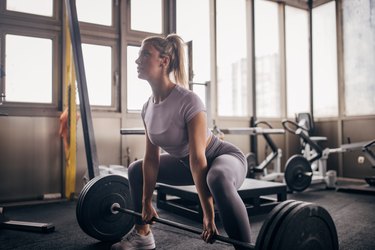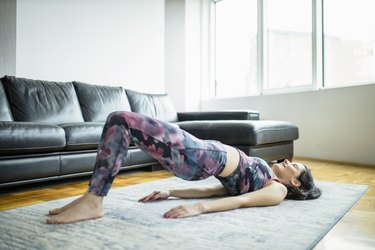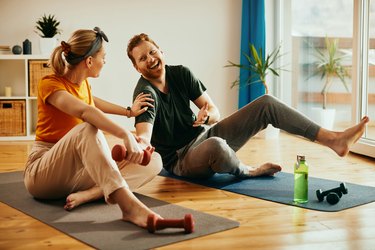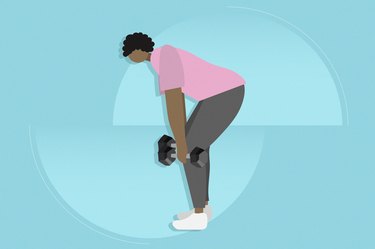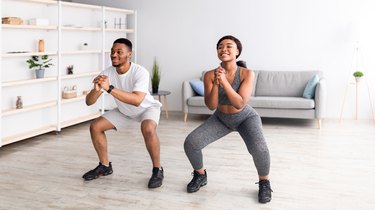
There's something awe-inspiring about watching a fellow gym-goer perform a heavy squat, hip thrust or deadlift. It's the absolute picture of power. And even though their strength may look impossible to match, everyone (yep, even that super strong gym-goer) starts at the beginner level.
Progressing to heavy lifts demands a lot of strength from your glutes, but it's totally achievable down the line. And the ideal place to start is with a few beginner glute exercises that are easy to do and don't require any extra equipment, explains Tatiana Lampa, CPT, creator of the Training with T app
Video of the Day
Another important key to building your glutes is working all, not just some, of the muscles. Your glutes include three separate muscles: your glute maximus (the largest, lower muscle), your glute minimus (the smallest on the side of your hips) and your glute medius (the highest right below the side of your lower back). You need to hit all three to safely build to more flashy exercises.
These six moves are the best glute exercises for beginners. Do them on their own or all together in order for a great beginner glute workout (start with 3 sets of 8-10 reps per move) and you'll be on your way to building bigger, stronger glutes.
Move 1: Lateral Band Walk
The lateral band walk is a fundamental strength-training exercise — and for a good reason. This move is a safe way to build beginner-level glute strength, specifically in your gluteus medius.
Many people unwittingly neglect this muscle, but it's crucial for keeping your hips and knees stable and pain-free.
To get the most out of this move, keep your knees bent during the entire exercise, Lampa says. That helps keep your muscle under tension and working their hardest.
How to Do It
- Place a resistance band around your ankles or thighs, just above your knees.
- Stand with your feet hip-width apart and lower into a mini squat. Brace your core.
- Maintaining the knee bend, step your right leg to the right, then repeat with your left foot, bringing your feet back to hip-width apart.
- Do this for a couple of reps to the right, then switch directions.
Move 2: Body-Weight Good Morning
Most of the things you do each day, like typing on a computer or texting on your phone, happen in front of your body. That means a lot of the muscles on the backside of your body (aka your posterior chain) get neglected, causing muscle imbalances.
Exercises like good mornings fire up your posterior chain, Lampa says. They're also a great intro for moves like dumbbell deadlifts, which require you to similarly get your hips back (aka hip hinge).
How to Do It
- Stand with your feet hip-width apart and knees slightly bent. Place your hands behind you head and brace your core.
- Keeping your back flat, push your hips back behind you and fold your torso forward.
- Stop once your torso is parallel to the floor or as far as comfortable.
- Press through your heels and squeeze your glutes to stand back up.
Move 3: Clamshell
When doing most glute exercises, your gluteus maximus — the largest glute muscle — tends to get the biggest share of the load. Clamshells are among the best glute exercises for beginners because they target the smaller glute muscles, like the gluteus medius. Strengthening this muscle can help reduce your risk of hip, knee and ankle injury, according to the American Council on Exercise (ACE).
This move is low-impact and equipment-free. Plus, you can easily progress this body-weight exercise by placing a resistance band above your knees, Lampa says.
How to Do It
- Lie on one side and stack your legs on top of one another, knees and hips bent at 90 degrees.
- Press your bottom leg into the floor and, with your heels pressed together, squeeze your glutes to raise your top knee toward the ceiling.
- Raise your knee as high as you can without letting your pelvis rock forward or backward.
- Pause, then slowly lower back to the starting position and repeat.
- Do all reps, then switch sides.
Move 4: Air Squat
Every time you sit into a chair and stand back up, you're doing a body-weight squat. Because many everyday movements involve squatting, it's important to build up your glutes so you can do them with ease and avoid injury as you first start training.
They're also super easy to modify or progress, Lampa says. To start, practice squatting into and out of a chair. And when you're ready up the challenge, hold a pair of dumbbells for extra resistance.
How to Do It
- Stand tall with your feet hip-width apart and brace your core. Focus on keeping your feet rooted into the ground and your core tight the entire time.
- Extend your arms out in front of you and slowly bend your knees as you push your hips back to lower toward the floor. Focus on lowering your body as if you were going to sit on a chair.
- Lower down as far as comfortable, or until your thighs are parallel with the floor.
- Pause for a moment at the bottom of your squat.
- On an exhale, reverse the motion by pressing through your heels to return to standing. As you stand, lower your arms back to your sides.
Move 5: Glute Bridge
The glute bridge is one of the best glute exercises, period. And it just so happens to be an ideal move for beginners.
Lampa loves the bridge exercise for glute gains, but for also easing lower back pain. In addition to strengthening your glutes and hamstrings, bridges activate the deep core muscle that wrap around your sides and spine. And building this 360-core strength can help keep your pelvis and lower back strong and stable.
Once you feel comfortable with this move, Lampa recommends adding a resistance band above your knees to better work your glute med and min. Next, try doing the dumbbell glute bridge — all you have to do is hold a single dumbbell across the top of your hips.
How to Do It
- Lie on your back with your arms at your sides, feet flat on the ground and knees bent.
- On an exhale, squeeze your glutes, press into your heels and drive your hips up toward the sky.
- Raise your hips until you form a diagonal line from your knees to hips to your chest.
- Pause here for a moment.
- Reverse the motion and return to the starting position.
Related Reading
Move 6: Frog Pump
While most of the other moves on this list strengthen several muscles at once (compound exercises), frog really isolate your glutes, according to Lampa. Isolation exercises focus on a single muscle group and are great to pair with compound exercises like the above.
You can do these on their own or as a finisher at the end of your glute workout to work the muscle to fatigue, aka when you can't do another rep with great form.
How to Do It
- Lie on your back, bend your knees and place the soles of your feet together, creating a diamond shape with your legs.
- With your weight in the outer edges of your feet, squeeze your glutes to raise them toward the ceiling.
- Pause, then slowly lower back to the floor.
Was this article helpful?
150 Characters Max
0/150
Thank you for sharing!
Thank you for your feedback!
